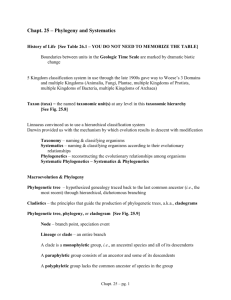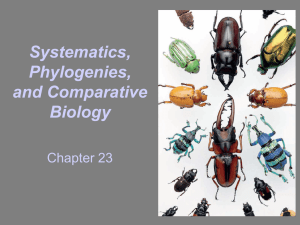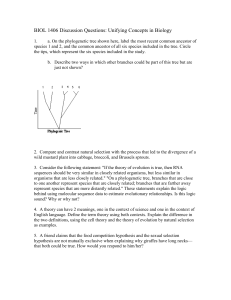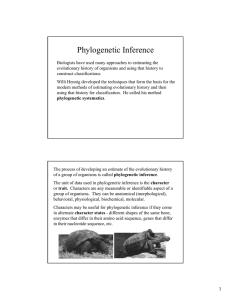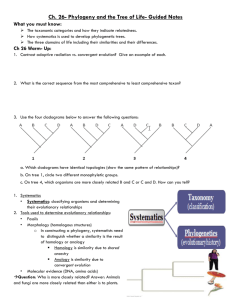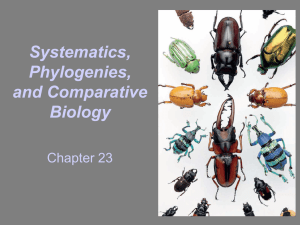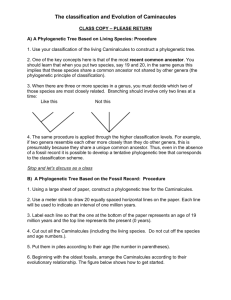Early Earth and the Origin of Life (Ch
advertisement
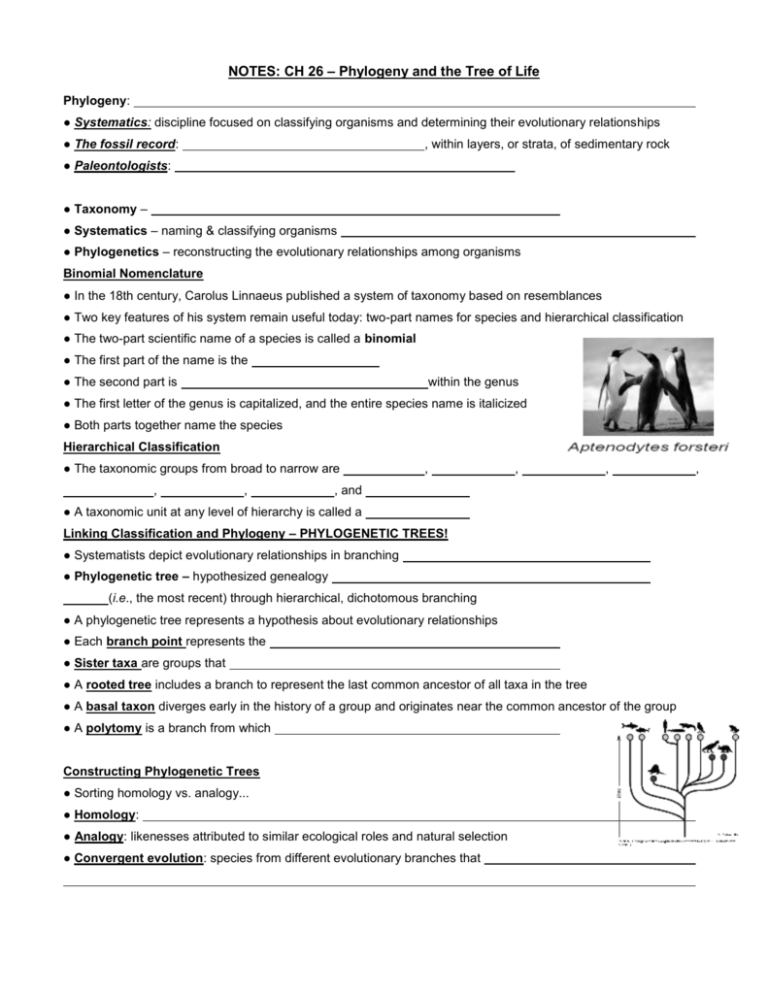
NOTES: CH 26 – Phylogeny and the Tree of Life Phylogeny: ● Systematics: discipline focused on classifying organisms and determining their evolutionary relationships ● The fossil record: , within layers, or strata, of sedimentary rock ● Paleontologists: ● Taxonomy – ● Systematics – naming & classifying organisms ● Phylogenetics – reconstructing the evolutionary relationships among organisms Binomial Nomenclature ● In the 18th century, Carolus Linnaeus published a system of taxonomy based on resemblances ● Two key features of his system remain useful today: two-part names for species and hierarchical classification ● The two-part scientific name of a species is called a binomial ● The first part of the name is the ● The second part is within the genus ● The first letter of the genus is capitalized, and the entire species name is italicized ● Both parts together name the species Hierarchical Classification ● The taxonomic groups from broad to narrow are , , , , , , and ● A taxonomic unit at any level of hierarchy is called a Linking Classification and Phylogeny – PHYLOGENETIC TREES! ● Systematists depict evolutionary relationships in branching ● Phylogenetic tree – hypothesized genealogy (i.e., the most recent) through hierarchical, dichotomous branching ● A phylogenetic tree represents a hypothesis about evolutionary relationships ● Each branch point represents the ● Sister taxa are groups that ● A rooted tree includes a branch to represent the last common ancestor of all taxa in the tree ● A basal taxon diverges early in the history of a group and originates near the common ancestor of the group ● A polytomy is a branch from which Constructing Phylogenetic Trees ● Sorting homology vs. analogy... ● Homology: ● Analogy: likenesses attributed to similar ecological roles and natural selection ● Convergent evolution: species from different evolutionary branches that , HOMOLOGIES: Similar characters (e.g., etc. traits or features) suggest relatedness… , ● Homologous characters ● As a general rule, the more homologous characters shared by two species, ● Sequences of DNA & RNA (nucleotides) and proteins (amino acids) are used as characters; as a general rule, the more recently two species shared a common ancestor, the CONVERGENT EVOLUTION: can produce superficially similar traits that lack homology with one another ● Analogous characters Evaluating Molecular Homologies: ● Systematists use computer programs and mathematical tools when analyzing comparable DNA segments from different organisms ● Molecular systematics uses and other molecular data (i.e. ) to Shared characters are used to construct phylogenetic trees ● Once homologous characters have been identified, they can be used to infer a phylogeny CLADISTICS: ● Cladistics groups organisms by ● A clade is a group of species that includes an ● Clades can be nested in larger clades, but not all groupings of organisms qualify as clades ● A valid clade is , signifying that it consists of the ancestor species and all its descendants ●A grouping consists of an ancestral species and some, but not all, of the descendants ●A grouping consists of various species with different ancestors Shared Ancestral and Shared Derived Characters ● In comparison with its ancestor, an organism has both and characteristics Ancestral vs. Derived Characters ● A shared ancestral character is a character that ● A shared derived character is of the taxon (“ ”) to a particular clade ● A character can be both ancestral and derived, depending on the context ● When inferring evolutionary relationships, it is useful to know in which clade a shared derived character first appeared **The sequence of branching in a cladogram then represents the sequence in which ( ) evolved Ingroup vs. Outgroup ● An OUTGROUP is a species or group of species that is closely related to the INGROUP, the various species being studied ● The outgroup is a group that has the ingroup ● Systematists compare each ingroup species with the outgroup to differentiate between shared derived and shared ancestral characteristics ● Characters shared by the outgroup and ingroup are that of both groups from a common ancestor An outgroup helps identify shared ancestral and shared DERIVED CHARACTERS ( ) Phylogenetic Trees with Proportional Branch Lengths ● In some trees, the length of a branch can reflect the that have taken place in a particular DNA sequence in that lineage ● In other trees, branch length can represent , and branching points can be determined from the Phylogenetic Trees as Hypotheses ● The best hypotheses for phylogenetic trees fit the most data: , and ● Phylogenetic bracketing allows us to predict features of an ancestor from features of its descendants -For example, phylogenetic bracketing allows us to infer characteristics of dinosaurs ● Birds and crocodiles share several features: four-chambered hearts, song, nest building, and brooding ● These characteristics likely evolved in a common ancestor and were shared by all of its descendants, including ● The fossil record supports nest building and brooding in dinosaurs , An organism’s evolutionary history is documented in its genome ● Comparing nucleic acids or other molecules to infer relatedness is a valuable approach for tracing organisms’ evolutionary history ● DNA that codes for rRNA and is useful for investigating branching points ● mtDNA evolves rapidly and can be used to explore recent evolutionary events (i.e. ) Molecular clocks help track evolutionary time ● To extend molecular phylogenies beyond the fossil record, we must make an assumption about how change occurs over time Molecular Clocks ● A molecular clock uses constant rates of evolution in some genes to estimate the absolute time of evolutionary change ● In orthologous genes (genes found in different species; e.g. nucleotide substitutions are proportional to the time since they last shared a common ancestor ● In paralogous genes (similar genes found within one species; e.g. ), nucleotide substitutions are proportional to the time since the genes became duplicated ● Molecular clocks are calibrated against branches whose dates are known from the fossil record ● Individual genes vary in how clocklike they are ),
